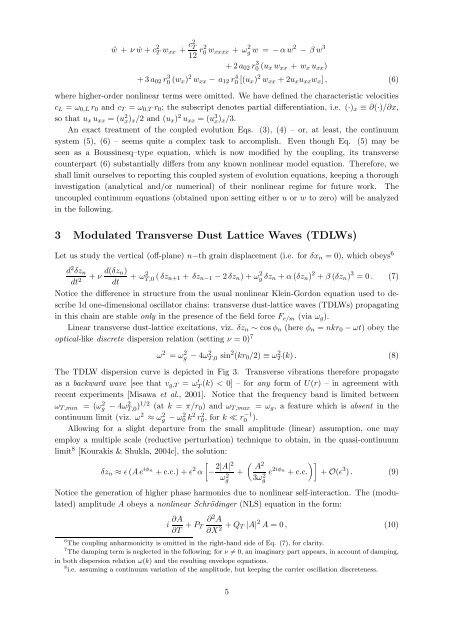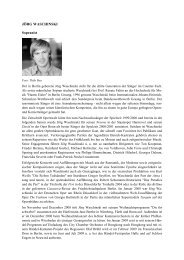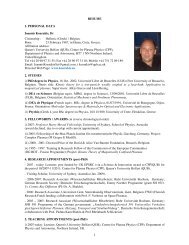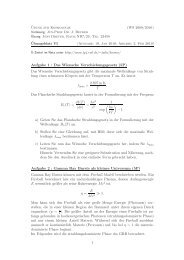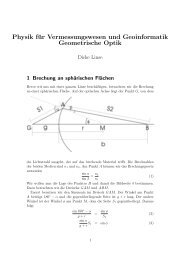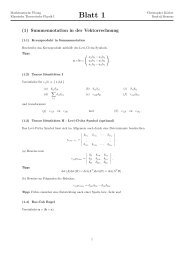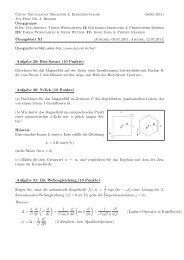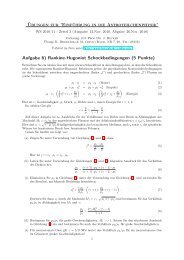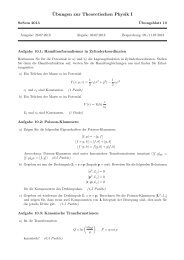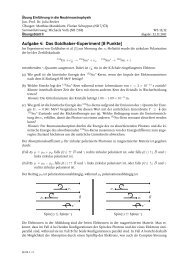View - Theoretische Physik IV - Ruhr-Universität Bochum
View - Theoretische Physik IV - Ruhr-Universität Bochum
View - Theoretische Physik IV - Ruhr-Universität Bochum
You also want an ePaper? Increase the reach of your titles
YUMPU automatically turns print PDFs into web optimized ePapers that Google loves.
ẅ + ν ẇ + c 2 T w xx + c2 T<br />
12 r2 0 w xxxx + ω 2 g w = − αw2 − β w 3<br />
+ 2a 02 r 3 0 (u x w xx + w x u xx )<br />
+ 3a 02 r 3 0 (w x) 2 w xx − a 12 r 4 0 [(u x) 2 w xx + 2u x u xx w x ], (6)<br />
where higher-order nonlinear terms were omitted. We have defined the characteristic velocities<br />
c L = ω 0,L r 0 and c T = ω 0,T r 0 ; the subscript denotes partial differentiation, i.e. (·) x ≡ ∂(·)/∂x,<br />
so that u x u xx = (u 2 x ) x/2 and (u x ) 2 u xx = (u 3 x ) x/3.<br />
An exact treatment of the coupled evolution Eqs. (3), (4) – or, at least, the continuum<br />
system (5), (6) – seems quite a complex task to accomplish. Even though Eq. (5) may be<br />
seen as a Boussinesq–type equation, which is now modified by the coupling, its transverse<br />
counterpart (6) substantially differs from any known nonlinear model equation. Therefore, we<br />
shall limit ourselves to reporting this coupled system of evolution equations, keeping a thorough<br />
investigation (analytical and/or numerical) of their nonlinear regime for future work. The<br />
uncoupled continuum equations (obtained upon setting either u or w to zero) will be analyzed<br />
in the following.<br />
3 Modulated Transverse Dust Lattice Waves (TDLWs)<br />
Let us study the vertical (off-plane) n−th grain displacement (i.e. for δx n = 0), which obeys 6<br />
d 2 δz n<br />
dt 2 + ν d(δz n)<br />
+ ωT,0 2 (δz n+1 + δz n−1 − 2δz n ) + ωg 2 δz n + α (δz n ) 2 + β (δz n ) 3 = 0. (7)<br />
dt<br />
Notice the difference in structure from the usual nonlinear Klein-Gordon equation used to describe<br />
1d one-dimensional oscillator chains: transverse dust-lattice waves (TDLWs) propagating<br />
in this chain are stable only in the presence of the field force F e/m (via ω g ).<br />
Linear transverse dust-lattice excitations, viz. δz n ∼ cos φ n (here φ n = nkr 0 − ωt) obey the<br />
optical-like discrete dispersion relation (setting ν = 0) 7<br />
ω 2 = ωg 2 − 4ω2 T,0 sin2 (kr 0 /2) ≡ ωT 2 (k). (8)<br />
The TDLW dispersion curve is depicted in Fig 3. Transverse vibrations therefore propagate<br />
as a backward wave [see that v g,T = ω T ′ (k) < 0] – for any form of U(r) – in agreement with<br />
recent experiments [Misawa et al., 2001]. Notice that the frequency band is limited between<br />
ω T,min = (ωg 2 − 4ωT,0 2 )1/2 (at k = π/r 0 ) and ω T,max = ω g , a feature which is absent in the<br />
continuum limit (viz. ω 2 ≈ ωg 2 − ω0 2 k2 r0 2 , for k ≪ r−1 0 ).<br />
Allowing for a slight departure from the small amplitude (linear) assumption, one may<br />
employ a multiple scale (reductive perturbation) technique to obtain, in the quasi-continuum<br />
limit 8 [Kourakis & Shukla, 2004c], the solution:<br />
(<br />
δz n ≈ ɛ(Ae iφn + c.c.) + ɛ 2 α<br />
[− 2|A|2 A<br />
2 )]<br />
+ e 2iφn + c.c. + O(ɛ 3 ). (9)<br />
ω 2 g<br />
Notice the generation of higher phase harmonics due to nonlinear self-interaction. The (modulated)<br />
amplitude A obeys a nonlinear Schrödinger (NLS) equation in the form:<br />
i ∂A<br />
∂T + P T<br />
3ω 2 g<br />
∂ 2 A<br />
∂X 2 + Q T |A| 2 A = 0, (10)<br />
6 The coupling anharmonicity is omitted in the right-hand side of Eq. (7), for clarity.<br />
7 The damping term is neglected in the following; for ν ≠ 0, an imaginary part appears, in account of damping,<br />
in both dispersion relation ω(k) and the resulting envelope equations.<br />
8 i.e. assuming a continuum variation of the amplitude, but keeping the carrier oscillation discreteness.<br />
5


